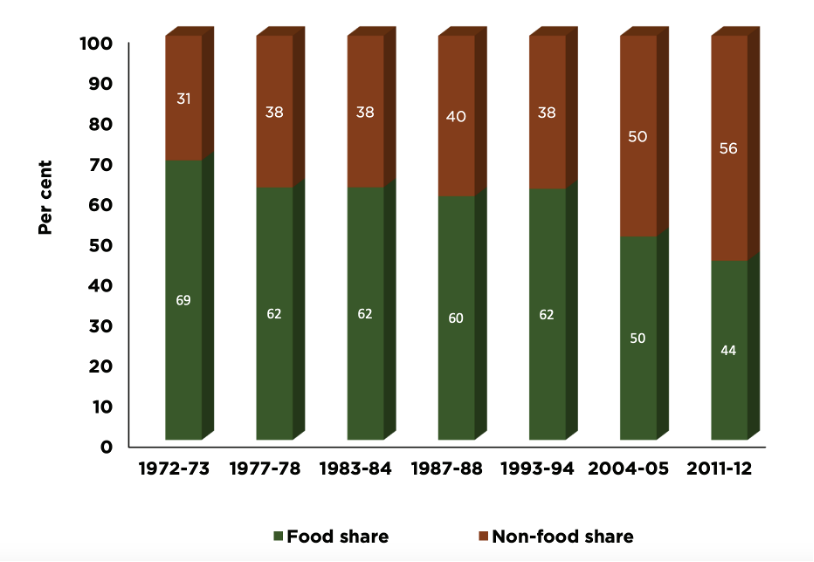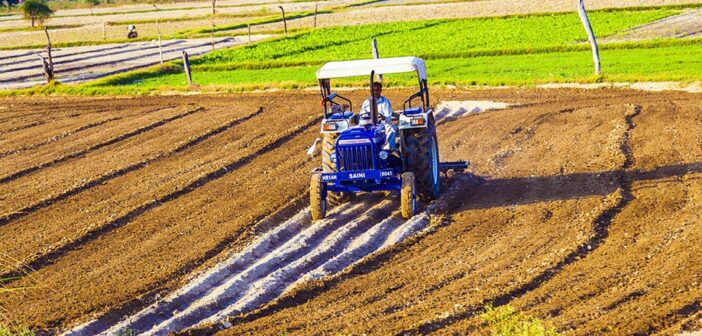The recently released NITI Aayog’s Working Group Report titled “Crop Husbandry, Agriculture Inputs, Demand and Supply” had highlighted growth trends in the agricultural sector in terms of yield, production, and consumption of different types of food commodities, since the 1970s, and projected the scenarios of demand and supply of various food commodities by the year 2047. Here is a review.
India aims to be among the developed nations by the centenary year of its independence i.e. 2047. According to the International Monetary Fund (IMF), India’s GDP has been growing at an average of 6% for the last two decades, making it one of the fastest-growing economies in the recent past. The GDP growth is also marked by advancement in various sectors such as Construction, Mining, Manufacturing, etc., including Agriculture.
The recently released National Institute of Transforming India (NITI) Aayog’s Working Group Report (WGR) titled “Crop Husbandry, Agriculture Inputs, Demand and Supply” highlighted growth trends in the agricultural sector in terms of yield, production and consumption of different types of food commodities, since the 1970s. Further, the WGR also projected the scenarios of demand and supply of various food commodities by the centenary year 2047, with a projected population of 1.6 billion. The study is aimed at evaluating the self-sufficiency and food security of India by the year 2047.
In this story, we look at past growth in the production, demand, and consumption patterns of various food commodities such as Cereals, Pulses, Vegetable and Fruits in India, along with their projected demand and production scenarios by the year 2047, as reported in the WGR
Household Consumption Expenditure (HCE) has increased, while the expenditure on Food Commodities has decreased
As per WGR, the HCE in India has increased significantly in the last few decades. When compared to the year 1972-73, the HCE in both food and non-food commodities has increased by 62% by the year 2011-12 (at 2011-12 prices); the total consumption expenditure (at 2011-12 prices) in 1972-73 was 983 rupees per capita per month (RCM), while it is 1599 RCM in 2011-12. Further, the share of expenditure on food commodities has come down to 44% in the year 2011-12 from 69% in the year 1972-73; At 2011-12 prices, the total expenditure on food and non-food commodities was 680 and 303 RCM, respectively, during the year 1972-73, while they were 708 and 891 RCM, respectively, during the year 2011-12. Therefore, it shows a significant difference in both household expenditure and in the amount of money spent towards food and non-food commodities.

The WGR highlights that this increase in household expenditure and decrease in the expenditure on food commodities is due to the consistent rise in the level of income of households across both rural and urban regions of India.
Cereals consumption has reduced, but the average consumption is higher than the daily recommended level
The WGR has analysed the past trends in the production and consumption of various food commodities such as Cereals, Pulses, Fruits, Vegetables, etc. The analysis has shown mixed trends in the production and consumption of various food commodities, as of the year 2011-12.
The report notes that 90% of cereals consumed in India are Rice and Wheat. The quantity of cereals consumed in the year 2011-12 was 27% higher at 357 grams per day per person (g/d/p) than the Recommended Dietary Allowance (RDA) of 281 g/d/p by the National Institute of Nutrition (NIN). However, the report notes consumption of cereals in the last couple of decades has reduced due to changing lifestyles, falling levels of energy requirement and other reasons. When compared to 1993-94, the consumption levels of cereals such as Rice, Wheat, Millets, and Maize have reduced by 14%, 1%, 67% and 70%, respectively, from 1993-94 to 2011-12. Thus, the consumption of Cereals has come down in the last couple of decades, though their average consumption remains higher, with 90% of their consumption constituted by rice and wheat alone.
Consumption of Pulses, Vegetables, Fruits, and Animal Source Foods has increased, but remain below the necessary consumption levels
The WGR also reports that unlike Cereals, the consumption of other food commodities such as Pulses, Vegetables, Fruits, and Animal Source Foods has increased, though their consumption is below the daily RDA. From the year 1993-94 to 2011-12, the consumption of pulses has increased from about 26 g/d/p to 27 g/d/p. This is far below the recommended level of 80-97 g/d; Similarly, consumption of Fruits, Vegetables and Animal Source Foods has increased by 21%, 14% and 12%. However, each of these commodities’ consumption is below the daily RDA of 103, 361 and 364 g/d/p, respectively.
Therefore, the WGR reports that unlike in the case of Cereals, though there is an increase in consumption of these products, their per capita consumption is below the recommended levels. However, the report also states that due to the changing patterns in the consumption of different foods, the demand for Pulses, Vegetables, Fruits, and Animal Source Food is likely to increase at a higher rate than the demand for Cereals.
Production of Important Food Commodities is already short of Demand in India
To estimate the demand and supply scenarios of various food commodities by 2047, the WGR looked at the current extent of land under agriculture, the yields, and the total production of different types of food commodities as of the year 2019-20, etc., along with the possibility of bringing additional land under agriculture.
Accordingly, the WGR noted that the net sown area in India has been hovering around 139 million hectares (MH). It also noted that there is no scope for bringing additional land under agriculture, except by the crop intensification process. Thus, whatever the present and future food needs of the country must be met from the total land which is under agriculture as of 2019-20.
As per the WGR, the total production of different types of important food commodities such as Cereals, Pulses, Vegetables, Fruits, and Edible Oils stood at 276, 23, 188, 102 and 12 million tons (MT), respectively. During the same period, the demand for these commodities stood at 251, 26, 199, 108 and 22 MT, respectively.
Therefore, except Cereals, the production of other food commodities in India is already short of demand. Notably, the demand for edible oils is double the amount of its production as of 2019-20. The WGR itself notes this as “Presently production of fruits and vegetables fall short of their demand which is expected to continue until acceleration in existing yield growth takes place. Similarly, shortfall in the production of edible oils is expected to continue in short run.”
Therefore, with no additional land available for agriculture, the WGR notes that there is no possibility of increasing the production of these commodities, except by the crop intensification process.
WGR says India will have sufficient production of Food by 2047, while ignoring important factors and challenges
As mentioned, as per the WGR itself, the production of some of the important food commodities is already less than the current demand. Along with these, India is also faced with other challenges related to its future food security, which are noted as follows in the WGR.
“For the past three decades, India’s net cropped area has been hovering around 139 million hectares; and there is little, if any, scope of bringing additional land under agriculture, except through intensification of the existing cropland. The water resources are limited, and the growing water scarcity has been posing a serious challenge to the intensification of the existing cropland. Groundwater in the intensively cultivated regions, as in Punjab and Haryana, has been over-extracted. Besides the quantitative limits on the utilization of these resources, their quality has also been deteriorating due to crop intensification. Further, pre-, and post-harvest losses in food commodities continue to be large, especially in perishable commodities such as fruits, vegetables, and milk. More importantly, climate change has emerged a significant threat to the sustainability of food production systems, and the threat is likely to be more pronounced in the plausible future climate scenarios”
The WGR itself notes important issues such as limited water resources and their scarcity, no additional land for agriculture, climate change, etc. all of which pose significant risks to the future food security of India. Therefore, any assessment on the same will have to take these factors into consideration and then project the plausible scenarios of Food Demand, Supply and Self-sufficiency.
As per WGR, by the year 2047, the projected land under Production of major Agriculture Commodities such as Cereals, Pulses, Vegetables and Fruits will be 98, 38, 15 and 11 MH, respectively, constituting to 162 MH. This is 15% more than the average net cropped area, which is 139 MH, of all the food commodities in India in the last 3 decades. Further, the respective production of major commodities will be 409, 47, 367 and 214 MT and demand will be 214, 34, 263 and 62 MT. Based on these figures, the WGR concluded that food production will be more than the demand.
However, in computing these figures, the WGR only taken two factors into consideration. The first was that the “Gross Cropped Area (GCA) is expected to increase at an annual growth of 0.45% from 2019-20 to 2047-48. The incremental acreage will come from improvements in cropping intensity.” Therefore, the increase in cropped area calculated by WGR is not based on an increase in the extent of land but only assumed increasing in the intensity of cropping. The other factor taken into consideration was by realizing the potential yield of agricultural lands, through technological and other types of improvements. The WGR notes that the current yields of agricultural lands are below the actual yielding capacity. Therefore, it takes actual yielding capacity into consideration. Based on these two factors, the report concluded that if the cropping intensity and potential yield are realized, the food production in India will be more than the demand by 2047.
However, while concluding so, the WGR did not take into consideration various important issues, factors and challenges which pose significant risks to food security of India. Firstly, the estimates provided are based on the ‘Business as Usual’ (BAU) scenario, which means that land under agriculture in 2019-20 has to remain under Agriculture even by 2047. This is highly unlikely since the WGR itself acknowledges that due to urbanization, agricultural lands are converted to non-agricultural purposes. As per the WGR, about 5 MH hectares of agricultural lands have been converted to non-agricultural purposes in the last two decades. This is accentuated by the fact that half of India is expected to be urbanized by 2047, as noted in the WGR. All this means that the increment in ‘Gross Cropped Area’ as estimated remains doubtful despite an expected increase in cropping intensity.
Similarly, the climate change-induced impacts such as changing monsoon patterns and their implications on crop yields, increasing temperatures, reducing soil quality, and water scarcity among others raise questions about the estimates provided in the WGR.



